Long before Gagarin. Space Dogs
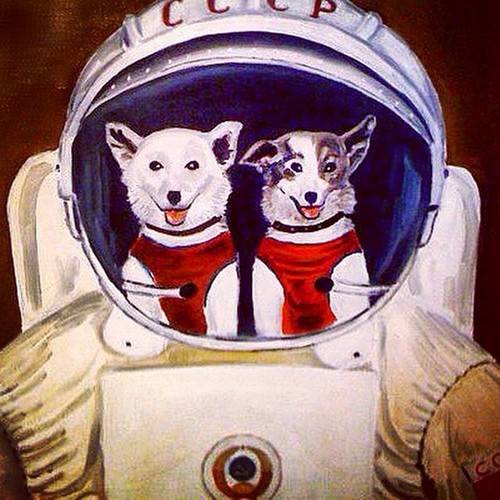
12 April every year we celebrate Cosmonautics Day. Many remember Yuri Gagarin, the first man to fly into space, someone Alexei Leonov, first to go into open space, someone else will remember about the Americans' flight to the moon, someone else will argue about whose rocket is better - the Russian " Angara "or the American" Antares "...
Few will remember those who paved the way for humanity to the stars - about our smaller friends, about dogs. And even more so about those who flew long before Strelka and Belka, and the world's first satellite.
Let's remember. how it all began
It all began with the fact that 13 May 1946 issued a secret decree of the Council of Ministers of the USSR No. 1017 — 419 ss, according to which the most important task was the development of weapons using jet engines and the organization of scientific research in this area. The decree marked the beginning of the country's rocket and space industry. In addition to military-strategic tasks, scientists were required to test the possibility of man’s flight into space. Since it was initially impossible to study the influence of space flight on man right away, it was decided to conduct experiments on animals. The main contenders for the subjects were higher mammals - monkeys and dogs.
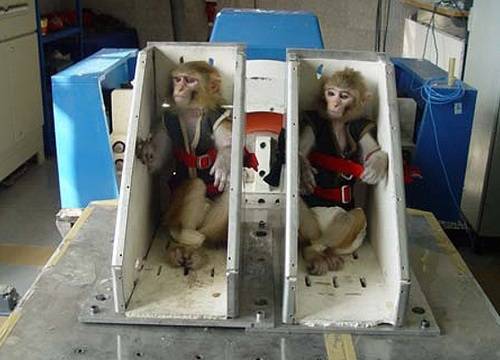
During the selection of candidates, it was found that the use of monkeys in experiments would not bring the desired results. Monkeys were difficult to train, were constantly anxious and disturbed researchers with their unpredictable behavior. They were harder than dogs under stress, so it was more humane not to use monkeys, under still unknown test conditions.
However, in the USA monkeys were the first experimental mammals, but for this they had to be completely restricted in movement or use of anesthesia, which adversely affected the accuracy of the data obtained during the experiments. Part of the monkeys died because of the use of anesthesia.
In the Soviet Union, serious experience has already been gained in using dogs as experimental animals. The scientist-physiologist Ivan Petrovich Pavlov used them in his research. For flight in space used mongrel and stray dogs. It was these animals that at the time of testing had already undergone natural selection in the conditions of the street and a wandering lifestyle: they had naturally strong health, ingenuity, were well adapted to stress, unpretentious in food, and easily subordinate to man.
In the autumn of 1947, Korolev proposed to lead research in this area to V. Yazdovsky, who at that time was in charge of the laboratory of spacesuits and pressurized cabins at the research institute aviation Medicine (NIIAM) Air Force of the Ministry of Defense of the USSR. NIIAM has developed a research program for the biomedical problems of rocket flights in the upper atmosphere.
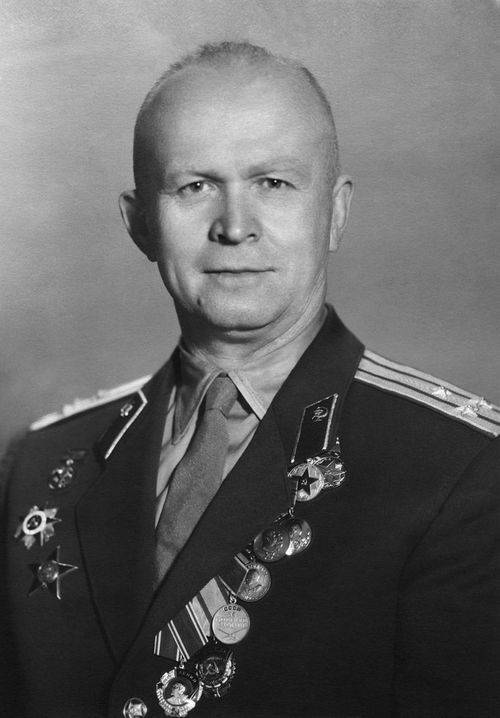
For work in the vivarium NIIAM not far from the stadium "Dynamo" gathered 32 Moscow mongrels.
Experimental dogs passed all the necessary types of tests that were carried out by scientists. They were taught to stay in a confined space for a long time, to carry strong overloads and vibrations, not to be frightened by loud and incomprehensible sounds, to be able to be in close experimental equipment, allowing them to record the received data from sensors fixed on the body.
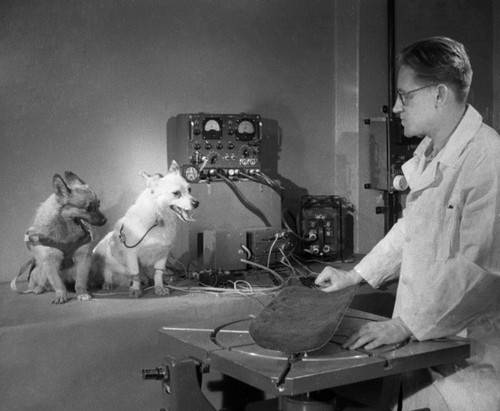
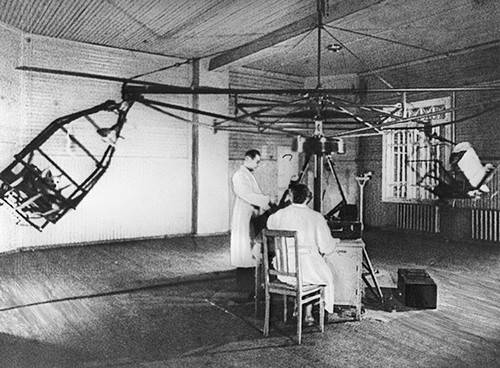
The dogs were selected according to special parameters dictated by the peculiarities of the research equipment and the size of the rocket passenger cabins.
Needed animals no heavier than 6 kg and no more than 35 in height. See For the correct location of the sensors most suitable short-haired dogs. By the summer of 1951, the first 14 dogs were prepared.
They were planned to be sent in flights in pairs in order to exclude the possibility of an individual reaction and to obtain more objective results. Studies of flying dogs in the upper atmosphere and into space were carefully classified. The complex and dangerous experiments of the new science did not pass without a trace for the experimental dogs. Training, training, flights on ballistic missiles could adversely affect their health. In addition, there were frequent deaths of animals during experiments. This was understood by scientists and researchers who worked with dogs at the time. They tried to create a comfortable living environment, they were well fed, taken for walks, combed. Many employees had their favorites, which they spoiled with delicacies from their own diet. Sergey P. Korolev, the chief designer of rocket technology, known for his love of dogs, personally inquired every day about their health and well-being. Each tragedy that happened to the dogs during the trials was perceived as a personal grief.
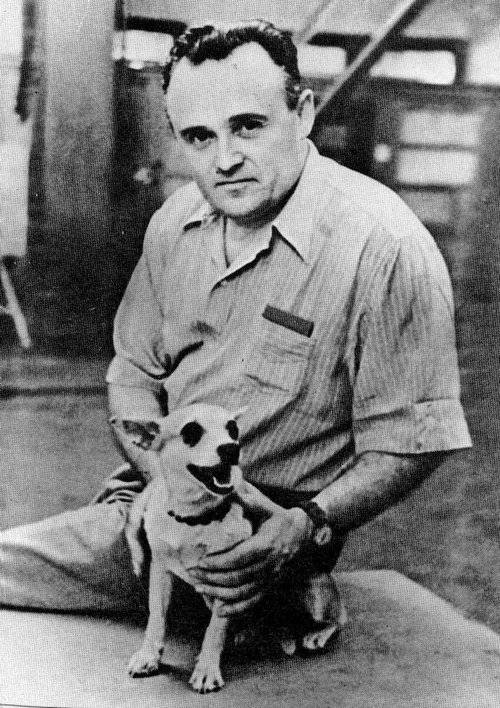
The researchers who worked with them never allowed themselves to call their pets experimental material, since during the joint work the dogs became for people more like colleagues and friends than objects of research.
The first studies were carried out with the help of the R-1B, R-1В geophysical rockets to an altitude of up to 100 km. During the flight, the rocket accelerated to 4212 km / h in a short period of time, the overload reached 5,5 units. The dogs were located in an airtight cabin on special trays tied with straps. Having risen to the required height, the rocket fell back, and the head part with the dogs descended on a parachute, which opened at an altitude of 5 — 7 km. Also, with the help of scientific equipment, parallel studies were conducted of the upper layers of the atmosphere and the nearest space.
Finally, the day of the first launch was approved. But which of the four-legged friends entrust the first flight? Agreed that the first to go into space Dezik and the Gypsywho demonstrated calm and endurance in all trials. So, Dezik and the Gypsy became the first living creatures, for the first time in stories made a flight on a ballistic rocket into the upper atmosphere to the conditional boundary with space.
The launch of the R-1B rocket with dogs on board took place at 4 in the morning hours. July 22 1951 city from the Kapustin Yar landfill.
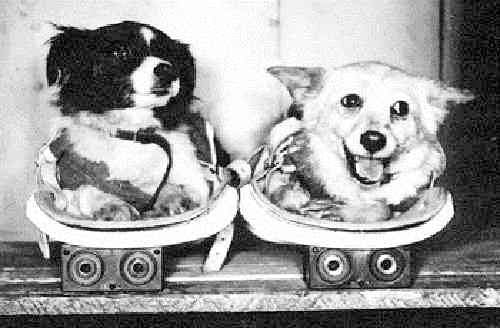
Here is how V. Yazdovsky remembers this: “Early morning 22 July 1951 of the year. The sun has not yet risen. Dezik and Gypsy are fed with light, but high-calorie foods: stew, bread, milk. They feel free to wear clothes fitted with sensors. The frequency of their pulse and respiration is recorded. Fully equipped, trapped animals behave calmly. Well done Dezik and Gypsy, knowingly practiced for a year!
An hour before the start, with a mechanic Voronkov, I climb the stairs to the upper platform of the rocket, opposite the access hatch of the hermetic cabin. We check the equipment. Then we take Dezik and Gypsy on trays, set them in their places, fasten them with special locks. We connect all the connectors from the sensors on the dogs to the onboard information transmission system. The final operation on the upper bridge of the rocket is the activation of the regeneration installation and the hatching of the hatch. I could not resist: before closing the lid, I took care of the dogs and, as if they could understand, wished them to return with a victory.
Voronkov and I descended from the upper platform, I reported to the Queen that everything was in order. He silently hugged me and invited everyone to go into the dugout. Before starting 20 minutes. Seven minutes before the appearance of the solar disk above the horizon, the rocket engine turns on, it is enveloped in a sea of fire and smoke, and finally it comes off the launch pad. And now a small asterisk rushes in the rays of the rising sun, carries our pets to the unknown. What awaits them there? Academician S. A. Khristianovich again skeptically remarked that animals are unlikely to survive. But for some reason I was sure of success. Ten or fifteen minutes after launch, a snow-white parachute appeared on the horizon, on which the head of the rocket descended. All who saw him rushed to the site of a possible landing. In one moment, all my requests and exhortations were forgotten! Everyone wanted to see the pioneers of space. The lucky ones, the first to reach the cabin, had already looked through the porthole. Their loud cries were heard: “Live, live!”. they opened the hatch, disconnected the plugs of the sensors, turned off the air regeneration system and dragged the animals on the trays from the cabin. When they were undressed, Dezik and Gypsy began to run, jump, caress for their experimenters, clearly ignoring everyone else. Their whole appearance expressed contentment, the tails worked without ceasing, and after the “masters” they went to the cars and sat down in their seats ”.
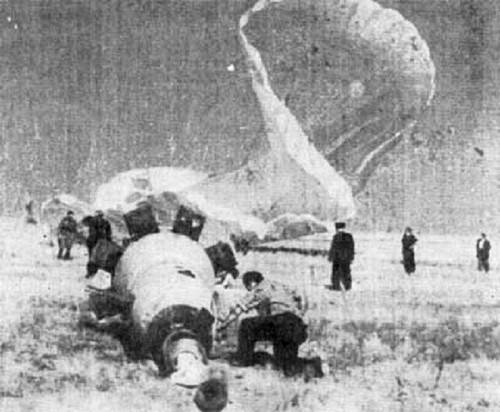
Alexander Seryapin, a medic, remembers one of those who opened the instrument compartment hatch after landing: “... The first flight was very successful, the dogs were alive. When we released them, a lot of cars drove up, one of them was Sergei Pavlovich Korolev. When he saw the dogs - in my opinion, the happier man was not there. He grabbed these dogs, ran with them around this very cabin. Watered them with water, gave sausage, sugar. Then he took them to his car ... "
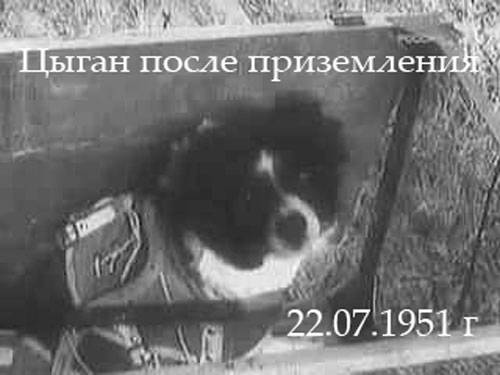
A thorough examination of Dezik and Gypsy showed that no changes in their physiological state were found, with the exception of a small injury from Gypsy - he scratched the skin on his stomach.
He no longer participated in the flights. Gypsy was taken to his home by the chairman of the state commission for organizing research on geophysical rockets Academician Blagonravov.
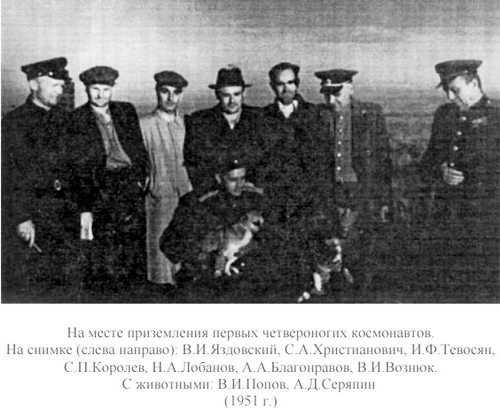
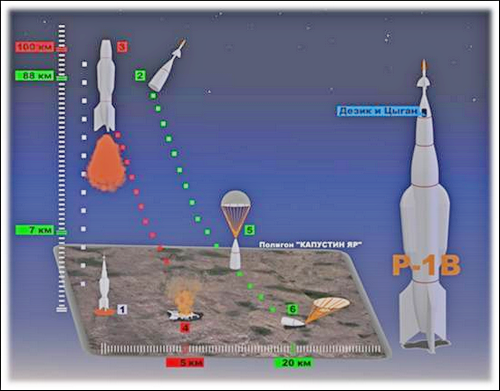
The rocket itself dropped into 5 km from the launch site and exploded.
For the flight used rocket R-1B (geophysical rockets, which are a modification of the rocket R-1). At the head of the P-1B rocket, compartments were mounted that extend it by 3 m as compared to the P-1. Directly to the instrumental compartment is the FIAN compartment (Physical Institute of the Academy of Sciences) with equipment designed to study the composition of the primary cosmic radiation and its interaction with matter. In front of the FIAN compartment there was an airtight compartment in which conditions were provided for the vital functions of the experimental dogs, and a parachute system for the rescue of the head part.
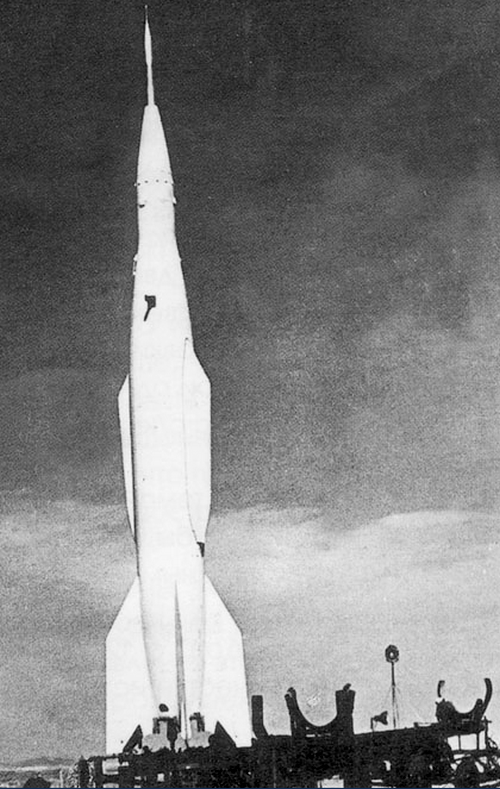
July 29 1951 city, a week after the first flight of dogs on a rocket, the second start took place. It was necessary to repeat the experiment that paved the way to space for man. There were dogs on board Dezik and Lisa. Dezik was sent to the flight again to check how the dog will behave when re-training and start.
As for the first time, everything went right on schedule. According to the memoirs of V. Yazdovsky. the rocket launched safely, at the eighteenth minute after the launch, they expected to see a parachute. But he was not there.
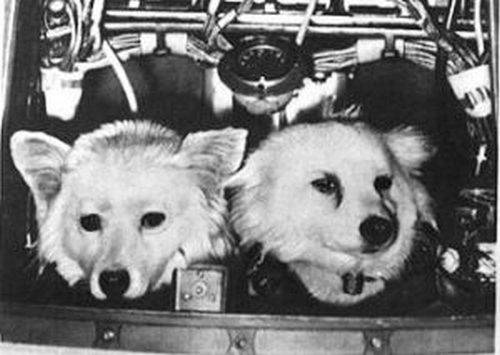
The aircraft were given the command to start the search for the landed head of the rocket with animals. The team on the cars was included in the search. About half an hour later, one of the planes received a signal that the cockpit was detected and the coordinates of the landing site. Cars with researchers went there. It turned out that the head of the rocket fell freely, and the parachute remained unopened in the container. Hitting the ground, the cabin collapsed and the animals died. But the testers received information from autonomous recorders and the film, as they were in armored cassettes. The commission to investigate the causes of death of animals has concluded that the vibrations led to the disruption of the normal operation of the baroret, a special device that provides for the input of the parachute system. Dezik and Fox died. So the sorrowful list of victims of space was opened. The death of dogs caused serious experiences of researchers, in particular, S. P. Korolev. After this incident, it was decided to develop an emergency ejection system for passengers from a rocket in the event of an emergency.
The reliability of the other units and the system of preparing animals was not in doubt. Understanding that it was difficult to manage without individual failures in such a large and complex new business, the commission recommended eliminating defects in the construction of the safety relay in order to proceed to the next stage.
It was decided not to send the gypsy more into the flight, but to save for research the long-term results of space travel. Until his death, the Gypsy lived with Academician Blagonravov at home, and no distant pathological changes were noted in him.
But it was impossible to stop. Therefore, preparing the third flight. For the crew selected Mishka and Siskin. Flight assigned to 15 1951 of August
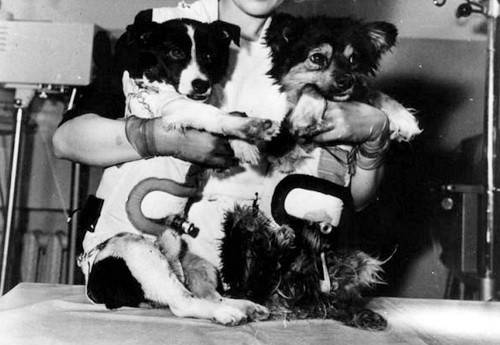
At night, researchers with animals and equipment moved from the mounting housing to the launch pad. Carefully and clearly done all the operations. The dogs behaved calmly.
At dawn, the rocket launched without any problems. As expected, at the estimated time, 18 minutes after the start, a parachute appeared in the sky. Despite the instructions, launch participants rushed to the landing site. Freed from trays and sensors, the dogs felt great, were caressed, despite the fact that they had recently experienced severe overloads. After the previous unsuccessful launch of Dezik and Lisa, researchers had a hope that the test program will continue to be carried out.
Began to prepare the next, fourth start. Candidates for the fourth flight were Bold and Ryzhik, who completed a full course of training in a laboratory in Moscow. Here they had to accustom them to a hermetic cabin in order to remove possible stresses arising in an unusual situation. As a rule, candidates for flight are kept separately and taken out for a walk with care so that other animals do not injure them. It was exactly the same with Ryzhik and the Brave.
And here 17 August afternoon Brave during a walk broke off the leash and ran into the steppe. Began to look for him, unsuccessfully. Fears were growing. The testers did not expect such a surprise. After all, dogs are selected in pairs, they also have psychological compatibility. There was a question: who should replace the Brave? It was saved that Ryzhik was calm, got along with everyone. We decided the next day, 18 of August, to pick up a pair of Ryzhik, but to say nothing about escaping the Brave so far. Imagine the amazement when in the morning they saw the Bold, who with a guilty air began to caress the experimenters. Immediately placed both dogs in an airtight cabin. It was necessary to determine whether the Brave lost the necessary skills during his trip to the steppe. The examination showed that the physiological state of the dog did not change, the reflexes remained.
Start took place 19 1951 of August Everything went as usual. Everything was fine at the landing site. Feeling brave, he behaved in a disciplined way and no longer ran into the steppe. With the most thorough examination of violations in the behavior and health of "astronauts" was not found.
The researchers accumulated numerous data, on the basis of which it was possible to draw up a program for training and flight of a person. There were two launches of the planned six, and the picture was already clear.
In the fifth flight went Mishka and Chizhik, which could be called "veterans of the cosmos." Re-staying in the hermetic booth did not cause them any negative reactions. They willingly participated in the experiment, showing with their whole appearance that the conditions of flight are quite portable.
The fifth flight was assigned to 28 1951 of August Korolev requires constant complication of experiments in order to bring the flight of a person closer. Therefore, to maintain the pressure in the cabin was installed spring automatic pressure regulator. According to the memoirs of Vladimir Yazdovsky, “He passed ground tests with excellent marks. But how will he behave in space? The mechanism of its action is based on the following. When the pressure in the cabin increases, the needle of the regulator is pressed out and opens a hole in the wall of the cabin. Excess gas mixture goes into open space. When pressure is normalized, the needle blocks the hole in the cabin wall ".
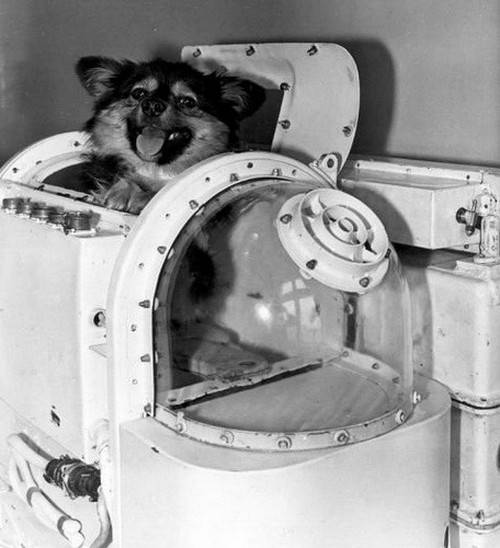
Start and landing took place as usual, according to the developed program, but, “Opening the door, we found that the dogs were dead. What's the matter? An analysis of the circumstances of the death of animals showed that the pressure regulator needle did not block the hole in the cabin wall, depressurization occurred and the animals died from lack of oxygen. Reverse needle movement during vibrations was not reliable enough. ”.
But this information, despite the failure, seemed very valuable to scientists. Designers were convinced that they would have to abandon the pressure regulator. In preparing the sixth flight, instead of a regulator, a hole was drilled in the cabin wall, the diameter of which was precisely calculated to release the gas mixture at an overpressure.
The sixth and final launch, the final stage of flights on geophysical rockets, was assigned to 3 September 1951 of P-1B missile passengers were assigned the Badminer and the Horn. On the eve, a complete check of the dogs and their physiological functions was carried out. Immediately before the start, the landfill staff noticed the absence of the Horn. The cage was locked, the unworthy in place, and the Horn inexplicably disappeared. There was almost no time to search for a new dog.
Researchers had the idea to catch a suitable for the dog near the dining room and send unprepared. So did. V. Yazdovsky recalls: “... they lured a suitable-sized dog, washed it, trimmed it, tried to attach sensors - the new candidate behaved quite calmly. Korolev decided not to report about the incident yet. Surprisingly, Neutiev and his new partner flew safely, the equipment did not let them down. ”.
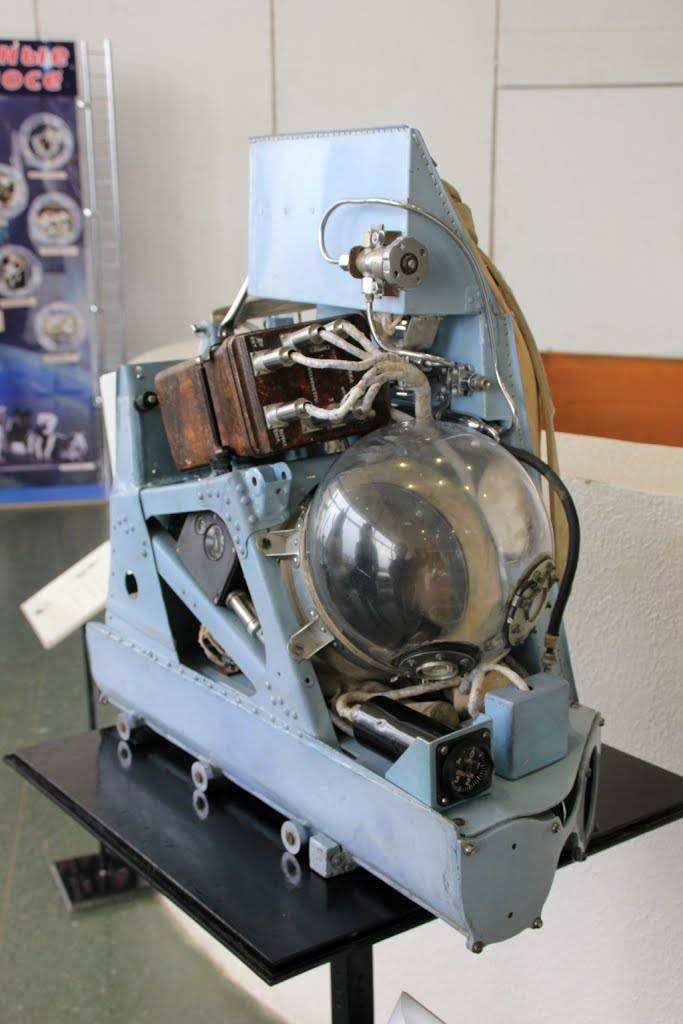
After landing, Korolev noticed the substitution, and he was told about what had happened. Sergei Pavlovich assured that soon everyone would fly on Soviet missiles. To the new passenger of the rocket, which, in addition to everything else, turned out to be also a puppy, was given the nickname ZIB (Spare Bobik). And on the management report, Korolev himself interpreted the abbreviation as “A spare researcher without training.”
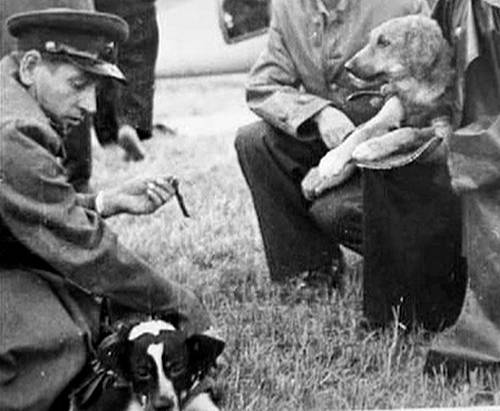
On this flight, the first stage of flights was completed during which issues such as:
- development of research methods for the physiological functions of the animal, suitable for use in rocket flight conditions;
- creation of a life support system for animals in an airtight cabin of small volume for flight to an altitude of 100 km;
- studying the nature and extent of the impact of flight to the upper atmosphere on the state of the physiological functions of the body and the behavior of animals;
- tests of control and recording equipment under unusual conditions.
During this series of flights, the animals were launched in an airtight cabin to an altitude of 100 km and more. On 177 — 183 seconds flight (at an altitude of about 100 km) occurred the separation of the head of the rocket from its body. Then, at a height of 6-8 km, the parachute opened and the animals descended to Earth in an airtight cabin. The total time the animals stayed in flight was 15-20 min.
At this stage, of the seven dogs in space - Gypsy, Dezik, Lisa, Mishka, Chizhik, Smelyy, Ryzhik - four died (Dezik, Lisa, Mishka and Chizhik).
The culmination of all flights of “sobakavat” became orbital flights around the Earth for a long time with the first cosmic velocity. The main purpose of experiments on spacecraft satellites launches was to study the influence of space flight factors on animals and other biological objects (overload, prolonged weightlessness, the transition from overload to weightlessness and vice versa), to study the effect of space radiation on animals and plant organisms. Medical and biological experiments and scientific research of outer space were also conducted.
The flights of dogs on satellite ships were supposed to prove the safety of orbital space flights for humans.
The first step on this path was to be the launch of the Objective D satellite, one of the variants of which, at the suggestion of Academician Keldysh, provided for the presence of a container with a “biological load” - an experimental dog. But the hurried race with the Americans for the launch of the first artificial satellite into space led to the construction of a simplified version without the "passenger" on board.
The result of this space race was the launch of October 4 1957, the world's first PS-1 satellite.
After the success of Sputnik-1, Khrushchev demanded that another satellite be launched from the OKB-1 to the 40 anniversary of the October Revolution. Under these conditions, 12 of October officially decided to launch the second artificial satellite by the 40 anniversary of the October Revolution. The chief designer decided to send a dog on the second satellite. It was clear - this is a kamikaze: then they did not know how to return the ship from space flight. Of the dozen trained "testers", three were selected first - Albin, Like and Mucha.
Lika, who went down in history, was chosen by the military doctor Vladimir Yazdovsky ten days before the launch. She became the first "declassified" astronaut dog. “Albina has flown twice and served science enough,” said Vladimir Ivanovich Yazdovsky. - Besides, she has funny puppies. We decided to pity her. As a cosmonaut chose a two-year Laika. She was nice, calm, affectionate. It was a pity her ... "
In the morning of October 31, 1957, the dog was prepared for landing on the satellite, and the skin was hygienically treated with diluted alcohol at the exit points of the conductors from the sensors. In the middle of the day, Laika was placed in a container, and around one in the morning the container was lifted onto a vertically standing rocket. The conditions of the animal's stay in the hermetic cabin of the satellite were quite satisfactory and did not significantly differ from those in which the animal was repeatedly found during long-term laboratory experiments.
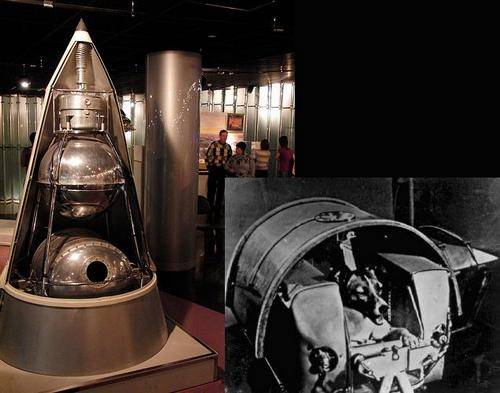
Employees of the medical service did not leave Laika for one minute. It was an autumn cold weather, and I had to tighten the hose with warm air from the ground conditioner to Laika. Before starting the hose was removed from the rocket.
The flight of the second satellite took place November 3 1957 city from the Baikonur Cosmodrome (Tyuratam). Sputnik-2 was a conical 4-meter capsule height, with a base diameter of 2 meter, contained several compartments for scientific equipment, a radio transmitter, a telemetry system, a software module, a regeneration system and a cabin temperature control. The dog Laika was located in a separate sealed compartment. Food and water were served to the dog in the form of jelly.
The fan for cooling the dog began to work at temperatures above 15 ° C. Technical and biological data were transmitted using the Tral-D telemetry system, which transmitted data to Earth during 15 minutes during each turn. On board were installed two photometers for measuring solar radiation and cosmic rays.
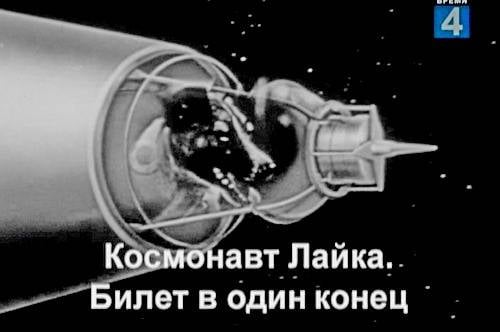
Very little time was allocated for the development of a new satellite, and it was not possible to improve the existing life support systems in such a short time.
Therefore, the experiment with Laika turned out to be very short: because of the large area, the container quickly overheated, and at the 4 th flight of flight the telemetry about the condition of the dog ceased.
Later studies have shown that Laika probably died from overheating after 5-7 flight hours. But this was enough to prove that a living organism can withstand a long stay in weightlessness.
The Telegraph Agency of the Soviet Union officially announced that "In accordance with the program of the International Geophysical Year for the Scientific Research of the Atmosphere, and also for the Study of Physical Processes and Living Conditions in Outer Space ... the launch of the second artificial satellite of the Earth has been launched." Then it was listed what research equipment was on board the satellite, and in the meantime it was said that the satellite besides “Sealed container with experimental animal (dog) ...”. The name of the dog was published only in a day.
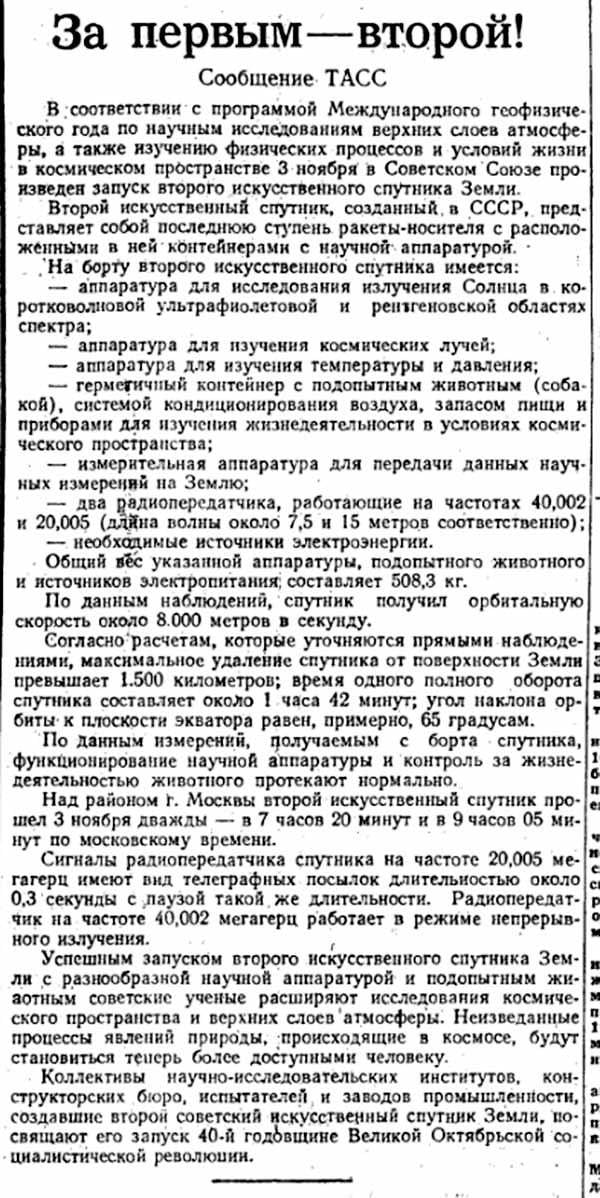
No one then knew that a dog whose portraits appeared in all the newspapers had a one-way ticket. Moreover, when her portrait was printed, she was already dead. Everyone who was involved in the experiment, knew that it was three to four hours for Laika to live in space. Neither of which weekly flight was out of the question. A serious technical error was made in the design of the cabin. Remodel was late. For experimenters, it was important how the dog would transfer the output to orbit and the few turns it would live and which would give valuable telemetry.
Laika spent several hours in zero gravity, and then, as the official reports say, she was put to sleep by the "astronaut". But it was a fine lie. The dog overheated in flight and presumably perished from heat and suffocation on the fourth turn. Meanwhile, newspapers and radio several times a day reported on the state of health ... already a dead dog.
A few months later, the second Soviet satellite with the dead Laika twisted the turns and only in April 1958, he entered the dense layers of the atmosphere and burnt.
After Laika’s launch in the Soviet Union, for almost three years biological objects were not sent into orbit: a return ship equipped with life support systems was being developed. At the beginning of 1960, it was developed - the Vostok ship, equipped with life support systems and a special return compartment. Who will experience it? Of course, on the same dogs! In flights on a spacecraft, it was decided to send only females. The explanation is the simplest: for a female individual it is easier to make a spacesuit with a system for receiving urine and feces.
July 28 1960 city A new type of spacecraft, the Vostok-1K-1, was launched. On board were dogs Chanterelle and Seagull. Chanterelle dog was the favorite of the general designer S. P. Korolev, whom he said before the flight: “I really want you to come back ...”
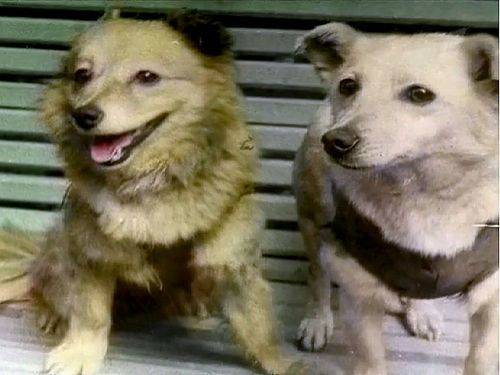
Due to the explosion of the combustion chamber of the engine 1-th stage at 29 seconds. flight launch ended in failure, so that she fell to the ground and exploded at 38 second. The dogs died.
After this incident, it was decided to develop an astronaut emergency rescue system not only in flight, but also during the preparation and launch phases.
19 1960 of August in 11 h 44 min. Moscow time from the launch complex number 1 (now the Gagarinsky launch) a successful launch of the second spacecraft-satellite into the Earth satellite orbit was carried out. The main objective of the launch of the second spacecraft-satellite was the further development of systems that ensure human life, as well as the safety of his flight and return to Earth. The flight included a number of biomedical experiments and the implementation of a program of scientific research of outer space. The successful flight of a second satellite-satellite with living creatures on board and returning it to Earth required the solution of the most complicated scientific and technical problems that ensure:
- controlled flight of the spacecraft and its descent to Earth with great accuracy at a given point;
- the conditions for the normal functioning of living beings in space flight;
- reliable radio and television communication with the spacecraft.
All these tasks have been successfully solved.
In the ejection container, in addition to two dogs, there were 12 mice, insects, plants, fungal cultures, seeds of corn, wheat, peas, onions, some types of microbes and other biological objects. Outside the ejection container, 28 laboratory mice and 2 white rats were placed in the cabin of the ship. The spacecraft with its passengers - dogs Belka and Arrow and other living creatures - safely returned to Earth.
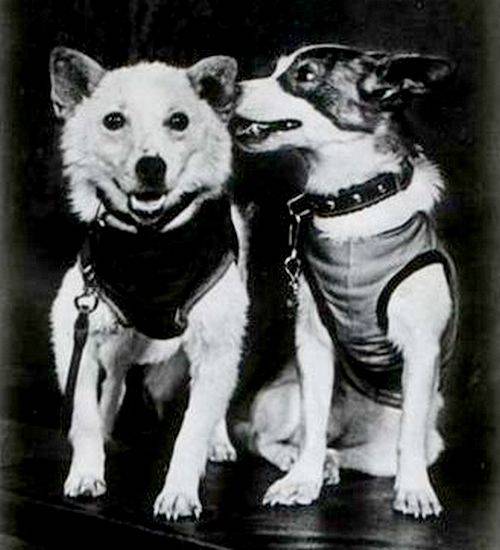
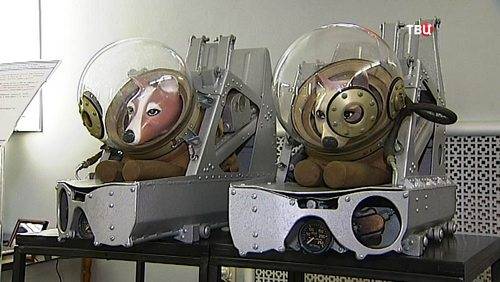
For the first time, television was used to observe four-legged cosmonauts. On board the spacecraft were placed 2 small television cameras. One camera was shooting through the container porthole Belka full face. The second camera through the side window transmitted the image of the Arrow in profile.
The flight lasted more than 25 hours, during which time the ship made 17 full turns around the Earth.
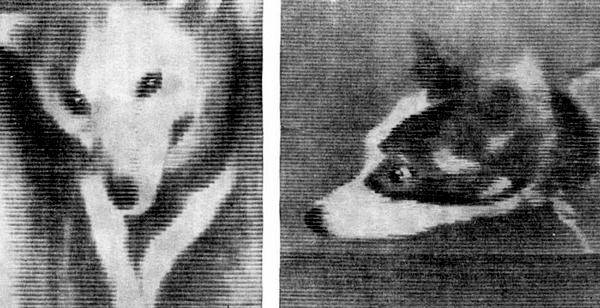
The cabin, in which Belka and Strelka were located, was placed in the ship two hours before the start. SP Korolev personally supervised the preparation of the ship for launch. The launch was successful, the rocket, looking up from the launch pad, regularly brought the spacecraft into orbit. During the start and ascent of the dogs, severe breathing and pulse were observed, but when the ship was put into orbit, they calmed down.
For the first time in the history of astronautics, constant monitoring of the state and behavior of dogs was carried out using a television system.
Video information transmitted from the ship during the passage of the satellite in the area of ground receiving points was recorded on film. Later, when viewing this film, it was possible to determine how the animal behaved at a certain moment and what physiological changes occurred during this period.
In addition, information accumulated while the ship was out of sight of ground services was transmitted to Earth later.
In flight, we recorded the frequency of the pulse, respiration, blood pressure (in the carotid arteries), electrocardiograms, phonocardiograms (heart sounds), animal movement and body temperature. The coordination of the movement of animals was studied with the help of television and contact-resistance sensors, which perceived the movements of animals and transmitted telemetry about them.
The state of weightlessness did not have a significant impact on the circulatory system. The temperature of the bodies of dogs did not change during the entire flight. However, after the fourth round of the Earth, Belka for some reason became extremely restless, tried to escape from the harness and barked. She became sick. Despite this, post-flight tests did not reveal any significant abnormalities in Belka.
In addition, there was an interesting episode. Shortly before the dogs' flight, NASA launched the passive communications satellite Echo-1 into orbit.
Because of its large size and mirror surface, it was very well visible from the Earth at night - the high reflectivity of the sun's rays made it the brightest artificial satellite. At that moment, when Belka and Strelka flew over Baikonur at night, the Echo-1, easily visible by a naked eye, flew over a higher orbit. At this time, for some reason, Belka and Strelka began to bark together. Observers at the screens of monitors had the impression that the dogs were barking at the American satellite, which gave a comic situation.
20 1960 of August in 13 h. 32 min. Moscow time on the 18 circuit from Earth was given a command to start the descent cycle. The braking propulsion system was turned on, and the ship descended from orbit. After some time, the descent vehicle landed successfully in a given area (Orsk-Kostanay-Amangeldy triangle) 10 km from the calculated point.
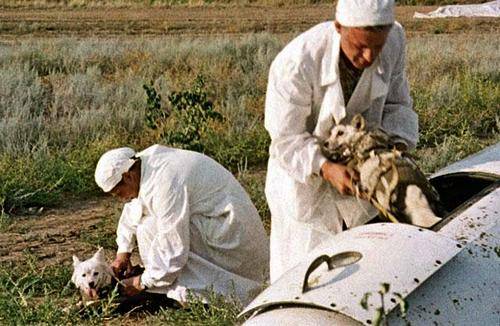
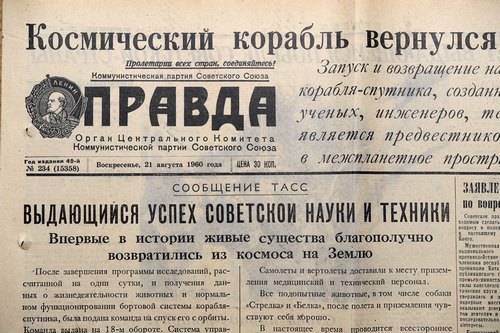
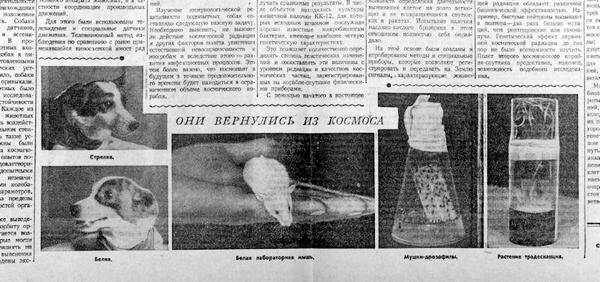
9 March 1961 city on the new modification of the ship "Vostok-3" Chernushka went into space. The flight program included a single turn flight. On board, besides the dog, there was a man's dummy, jokingly called Ivan Ivanovich. Mice, guinea pigs and other biological objects were placed inside the dummy in order to study the effect of radiation. The flight went well, the equipment worked flawlessly. The descent vehicle landed in the Kuibyshev region (the dummy was catapulted).
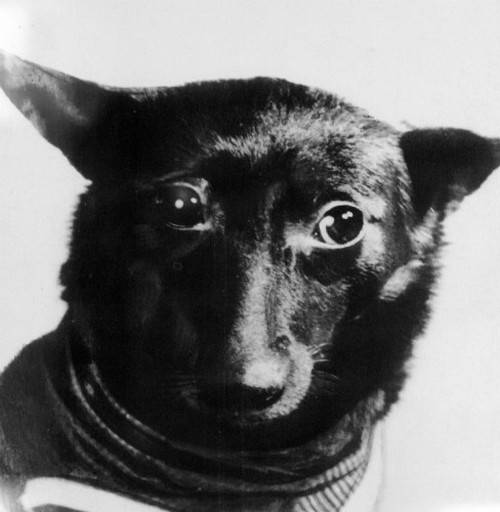
March 25 flight on a similar program made an asterisk. The flight went well, the descent vehicle landed in 45 km southeast of Votkinsk. A mannequin Ivan Ivanovich also flew with the dog. Dummy nominally ejected. Along the way, photo-sensing equipment was tested on objects in Turkey and Africa. After completing the flight, the Asterisk was given to the Moscow Zoo, from where it safely escaped. So now a significant part of Moscow mongrels can be proud of their ancestry.
Experience has shown that flying dogs on the Vostok ships took place with some changes in their physiological state. Symptoms manifested after the fourth round. This made it necessary to plan the first upcoming manned flight into outer space with a duration of no more than one orbit with maximum automation of control modes. Before the launch of man into space, there were 18 days left.
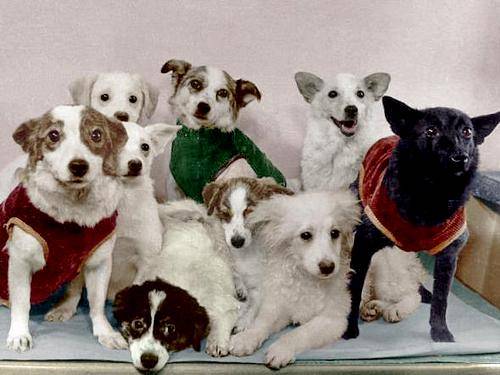
Sources:
Slavin S.N. Space battle of empires. - M .: Veche, 2006. - C.83.
Yazdovskiy V.I. On the Paths of the Universe. - M .: Publishing "Slovo", 1996.
Flying dogs // http://rocketpolk44.narod.ru/kosmos/sobaki.htm.
Astronaut dogs // http://staff-bull.kz/forum/index.php/topic,26.0.html.
Dogs in space. USSR // http://muldyr.ru/a/a/sobaki_v_kosmose_-_sssr_geofizicheskie_raketyi.
Dog astronauts // http://ksenia-schatalina.narod.ru/.
Soviet dogs astronauts // http://pksite.emitr.ru/space_animals/dog/ussr/dogussrindex.php.
Cosmonaut Laika: Unknown Facts // http://russian7.ru/post/neizvestnaja-istorija-lajki-pervoj-sobaki-kosmonavta.
The first dog cosmonaut Laika // http://wolcha.ru/polezno-znat/410-pervaya-sobaka-kosmonavt.html.
Dog astronauts: heroes involuntarily // http://dogsecrets.ru/stati/1153-sobaki-kosmonavty.html.
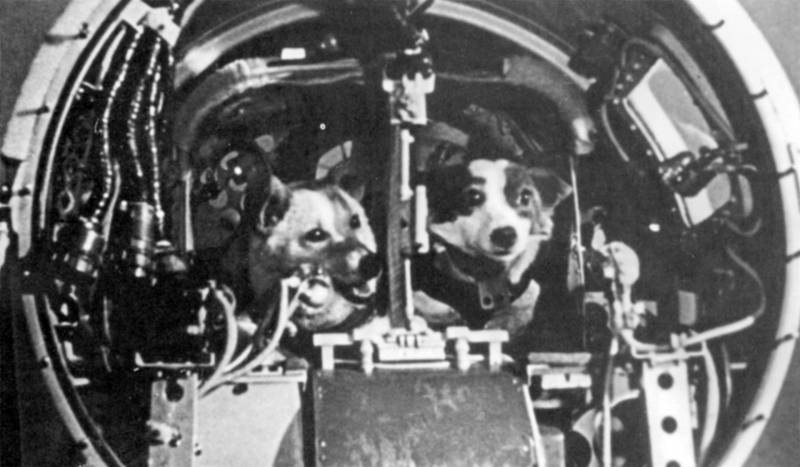
Information